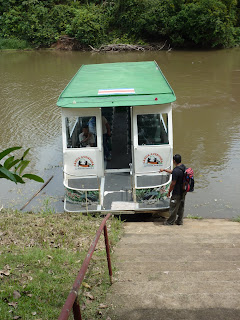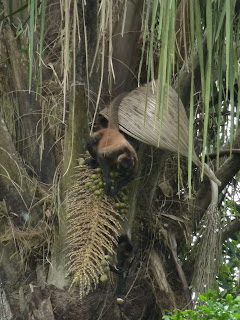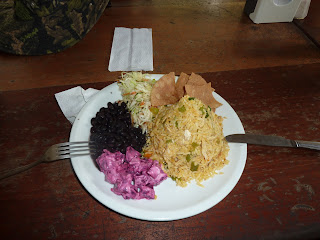Our time in Uvita had drawn to a close - we said our goodbyes to the great folks that run the place - Tra and Elizabeth, and boarded our shuttle bus to La Fortuna. We had decided to visit La Fortuna for a number of reasons - it's in the northern region of the country and is built in the eastern shadow of one of the famous volcanoes of Costa Rica - Arenal Volcano. On the western side of the volcano is a man-made lake (Lake Arenal) that serves as a source of water for a major hydroelectric scheme, as well as a great place for windsurfing.
The trip to La Fortuna took around 8 hours - even with a typical tico driver behind the wheel! Just in case you haven't heard, Costa Rica is known for being a dangerous place to drive. The normally gentle people morph into demons and drive like they're being chased by the hounds of hell. Overtaking on blind rises and corners are the order of the day, and seeing a huge Mack truck bearing down on you can be slightly nerve-wracking. The whole of Costa Rica is pretty much hills and mountains, so getting anywhere can take a lot of time.
 |
| Lake Arenal from the western side |
 |
| More of Lake Arenal |
The north-western side of Costa Rica is a lot drier and less forested than other areas, and as we travelled inland from Puntaneras towards Arenal we noticed cattle ranches becoming prevalent. Then as we crested the hills on the western side of Lake Arenal, we were provided with a spectacular view of the lake with the volcano being clearly visible on the eastern side. As we descended towards the lake, the vegetation became thick forest again, and we passed numerous tourist lodges as we wound around its northern edge. Eventually we crossed the dam wall, and the volcano loomed up ahead of us. As we passed around the eastern side of the volcano, the town came into view, and soon we were in the bustling tourist town of La Fortuna.
 |
| Arenal volcano |
 |
| Arenal volcano from the road |
We hadn't booked a hotel, so we alighted at the main shuttle drop-off point, and walked around until we found a great little hotel called Pepito's Place. Great value for money, very clean and modern, but the lack of self-catering facilities meant that we would have to eat out for most of our meals.
We decided that we'd like to see some wildlife up close, so we arranged through the hotel to go on a riverboat cruise the next day. The cruise would take place within a nature conservancy called
Silvestre Caño Negro, close to the Nicaraguan border. So at 07h30 the next day, we were picked up by a small bus and headed out towards the reserve. Along the way we stopped for a coffee break at a roadside restaurant, where we were treated to the sight of huge iguanas living in the nearby trees beside a river. Being able to see these huge lizards up close gave us a taste of what was to come.
 |
| Iguanas! |
 |
| More iguanas! |
After a 2 hour drive, we finally arrived at the reserve and had a quick snack before boarding the boat. Within minutes of being on the river, the guide pointed out some sleeping long-nosed bats on a riverside tree. Soon after that we spotted a sloth quietly munching its way around the top of another tree, which was followed by the sighting of camans (related to crocodiles), "slider turtles", numerous bird species, spider monkeys and howler monkeys. What an amazing treat to see these wonderful animals in the wild instead of a zoo. We returned to the riverside lodge where we had a delicious lunch of (you guessed it) chicken, beans and rice.
 |
| The riverboat |
 |
| The river |
 |
| A caman |
 |
| Spider monkeys |
 |
| Lunch! |
The following few days were spent exploring the town (we considered hiring some quad bikes but the tourist rates are steep), doing some shopping and generally eating too much. One evening we were sitting in our room doing some reading when the floor started rocking from side to side. After a moment of puzzlement we realised - earthquake! It turned out that the epicentre was near San Jose, hundreds of kilometers away. Watching the news was sobering - the capital city was rocked by a 5.8 on the richter scale.
Our time in La Fortuna was drawing to a close, so after perusing the map we decided that our next stop would be the mountain town of Monteverde. And so we booked our ticket for another early morning bus ride.
Hasta luego..